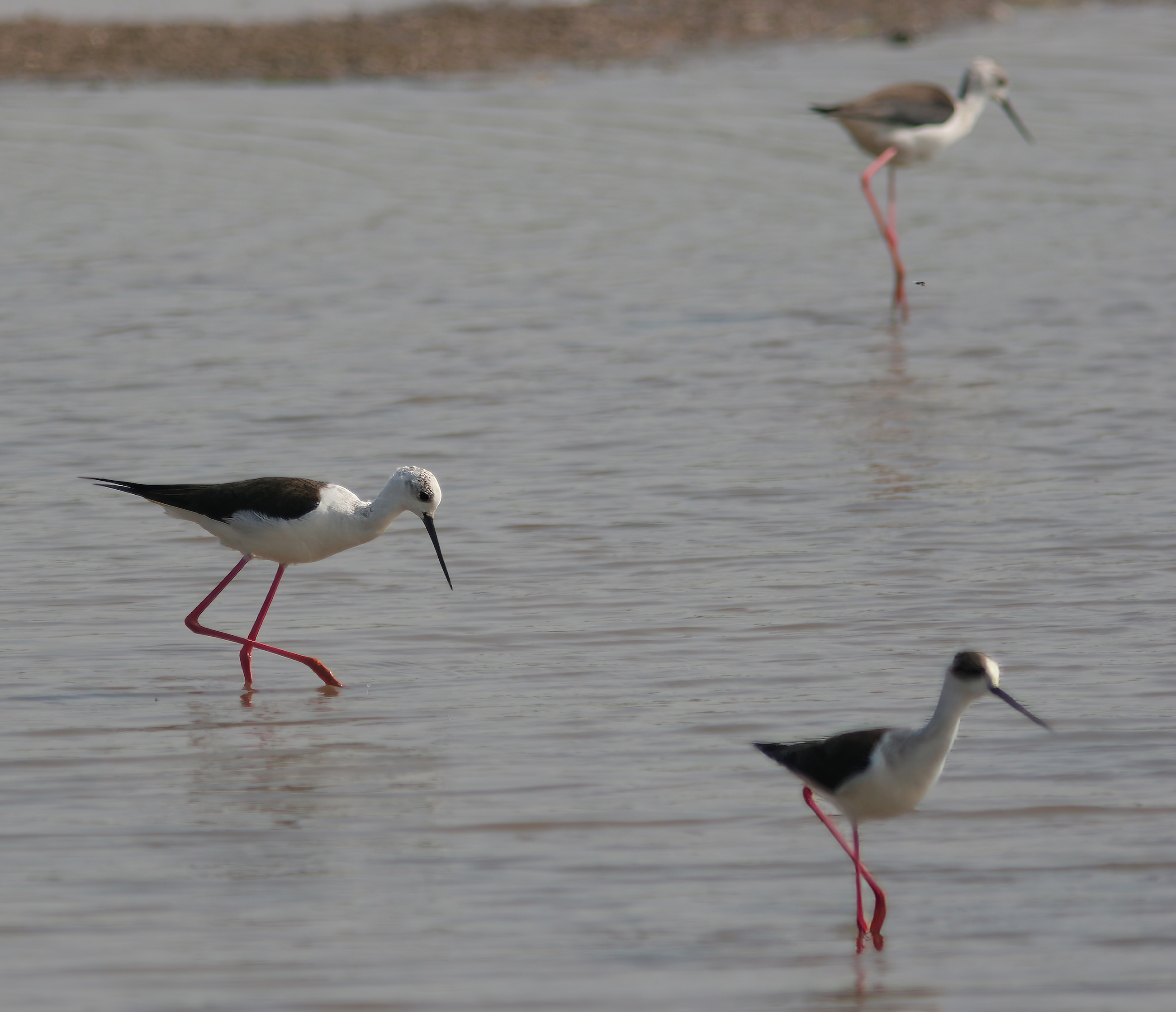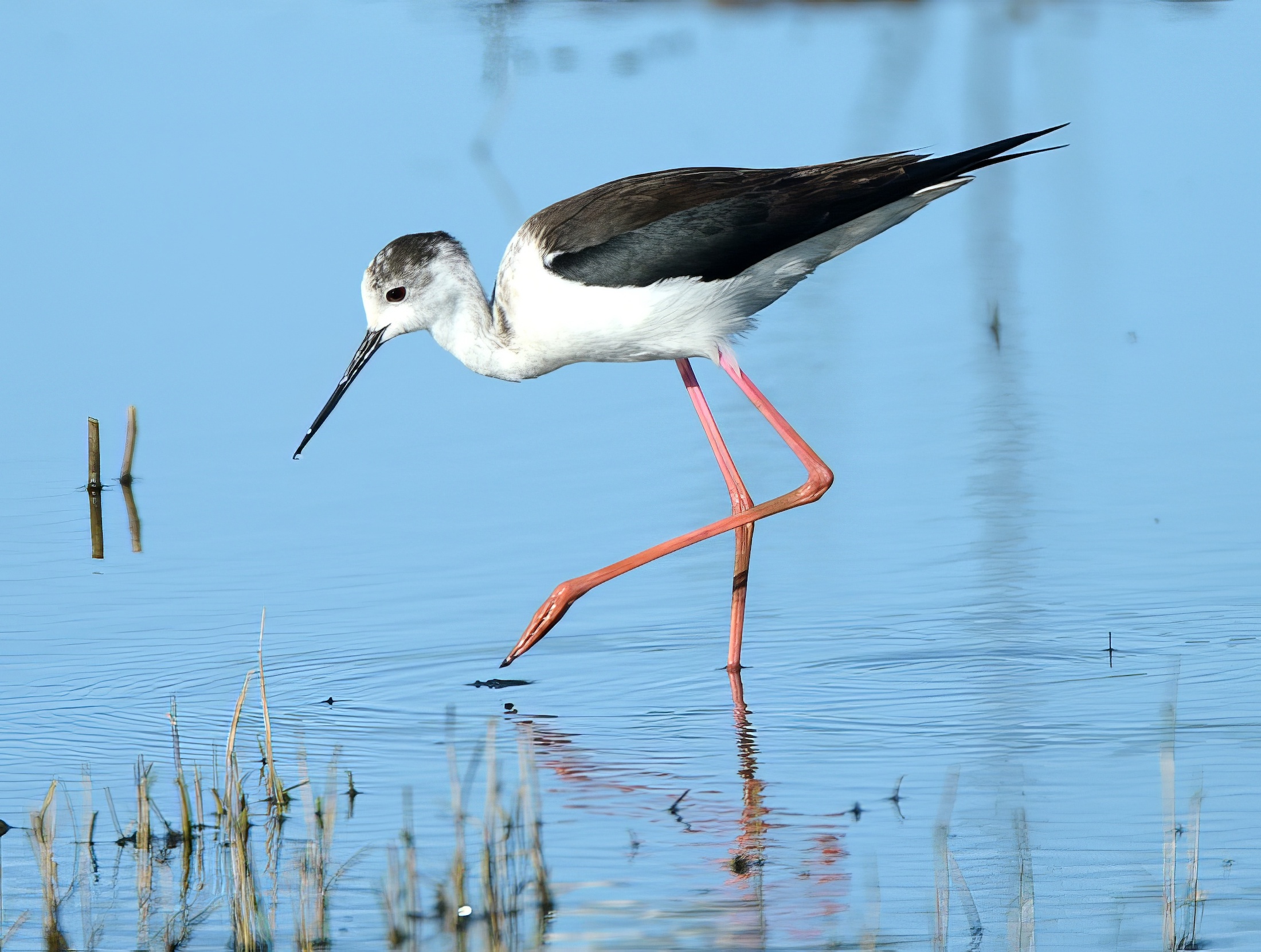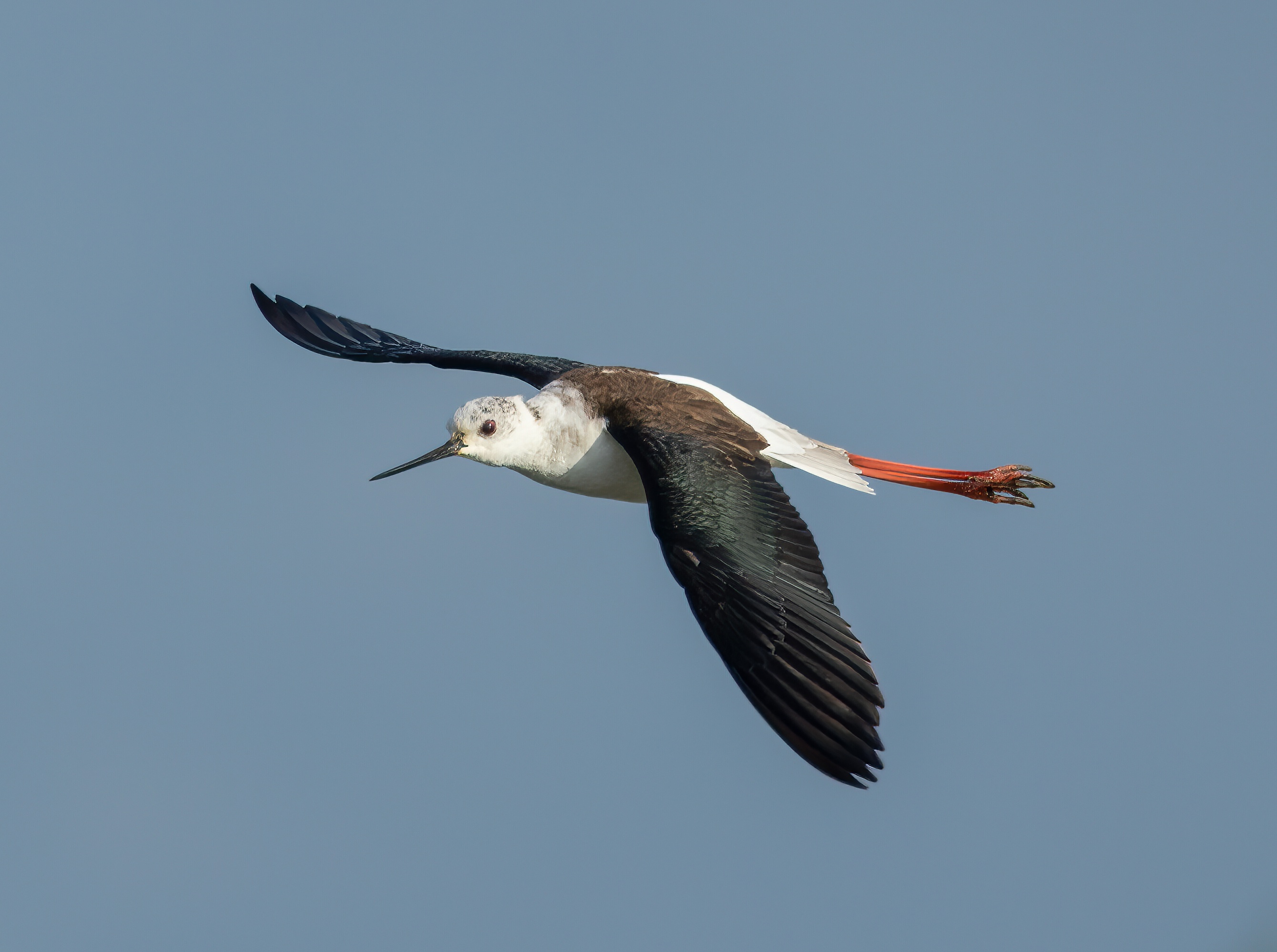Black-winged Stilt Himantopus himantopus



Black-winged Stilts are said to have occurred very rarely in the Fens in the eighteenth century, but no actual records have been traced. Similarly, Lorand and Atkin (1989) reported four historical records from 1824, 1888, and 1889 that are unsubstantiated; there is also an undated specimen in Grantham Museum that is of uncertain geographical origin. None of these records have been admitted to the Lincolnshire List. The first record was of two birds flying south along the shoreline at GPBO April 26th1965. A very unseasonal bird was at Grantham STW December 25th 1968 and presumably the same bird there February 2nd-6th 1969. The next was not until more than 20 years later in 1986 and it remained a rare bird until the mid-2000s when three turned up at Barton Pits in 2006. From 2010 onwards they have become almost annual with potential breeding birds present at Frampton Marsh in 2015, 2017 and 2018. There were no records 2019-2020.
A pair present at Frampton Marsh in May 2015 were seen mating and building a nest but did not settle. The same behaviour was reported in May 2017, but the birds were scared off by foxes. A lone bird hung around for three weeks in May 2017. With successful breeding in adjacent counties, superb habitat and new predator proof fencing at RSPB Frampton Marsh, the first Lincolnshire hatched chicks cannot be too long coming.
| Site | First date | Last date | Count | Notes |
| Gibraltar Point NNR | 26/04/1965 | 2 | Pair flew south down the shoreline at1530hrs, about 30-50 yards out | |
| Grantham STW | 25/12/1968 | 1 | ||
| Grantham STW | 02/02/1969 | 06/02/1969 | 1 | Same as December 1968 bird |
| Tetney marshes | 19/06/1986 | 1 | Adult | |
| Barton-on-Humber/South Ferriby area | 06/09/1987 | 13/09/1987 | 1 | 2CY |
| Covenham Reservoir | 06/05/1991 | 1 | ||
| MOD pools, North Coates | 21/04/1993 | 1 | ||
| Huttoft car terrace & Huttoft Pit | 05/05/1997 | 1 | 2CY, probably female | |
| Barton upon Humber | 04/05/2006 | 3 | 2CY birds; relocated to Cheshire and two attempted to breed | |
| Frampton Marsh | 29/05/2010 | 2 | Adults | |
| Willow Tree Fen LWT reserve | 14/04/2012 | 17/04/2012 | 1 | Adult female |
| Frampton Marsh | 19/04/2012 | 18/05/2012 | 1 | Adult female, same as Willow Tree Fen bird |
| Saltfleetby-Theddlethorpe NNR | 13/10/2012 | 1 | Flew south along the dunes | |
| Frampton Marsh | 07/05/2013 | 1 | Adult male | |
| Frampton Marsh | 03/06/2013 | 2 | Adults | |
| Grainthorpe & Covenham Reservoir | 04/05/2015 | 09/05/2015 | 1 | Female |
| Frampton Marsh | 27/05/2015 | 28/05/2015 | 2 | Pair, display, mating and nest building were observed but the breeding attempt went no further. First county breeding attempt |
| Frampton Marsh | 03/05/2016 | 04/05/2016 | 1 | 2CY+ female |
| Anderby Marsh | 05/05/2016 | 07/05/2016 | 1 | 2CY+ female, presumed same as Frampton Marsh bird |
| Frampton Marsh | 11/05/2017 | 12/05/2017 | 2 | Pair, display, mating and nest building were observed, failed, ? Fox disturbance |
| Frampton Marsh | 01/05/2018 | 28/05/2018 | 1 | Male |
| Freiston Shore | 29/05/2018 | 31/05/2018 | 1 | Same male |
| Frampton Marsh | 01/06/2018 | - | 1 | Same male |
| Messingham SQ | 05/08/2022 | 06/08/2022 | 6 | Pair + 4 juveniles originally bred at Potteric Carr, Yorkshire; one juvenile taken by a predator. |
| Frampton Marsh | 01/05/2023 | 24/08/2023 | 10 | Two pairs bred fledging six chicks; first successful breeding in the county. |
| Kirkby GP | 03/05/2023 | 2 | A pair were present on May 3rd only; it is not known if these two had wandered from Frampton Marsh. |
Finder’s report: Black-winged Stilt at Marston STW, December 25th, 1968
by P. D. Mackenzie
Note: this was the second county record; account taken from the original BBRC submission. This brought the British total to around 30 records, involving some 45 individuals, since 1958, but none in Ireland. Eight individuals was the second highest annual total since 1958 (20 were recorded in 1965).
Circumstances
I saw a Black-winged Stilt probing about in water meadows about a half mile west of Marston STW (TF884425) at about 3.30pm. It looked to begin with as if it had short legs, only those parts above the knee visible. A Black-headed Gull and Redshanks were promenading the edges of the water; the former appeared larger than the Stilt, the latter smaller. Already at this stage the sharp outlines of the colour on the bird were recognised as unfamiliar to the observer.
After the main features were noted, the bird came out of the water on to grass border and the legs were now seen to be twice the length the observer originally thought that they were. Minutes later the bird was in flight and the long pink legs were seen to project a considerable distance beyond the tail, reminding the observer of the similar appearance of a heron in flight. The bird circled the field, landing much further off in a similar patch of water.
The bird had been watched in bright sunlight, temperature 400F and using Pentax 8x30 binoculars, and for 10-15 minutes. Other species present included Black-headed Gull, Starling, Carrions Crow, Lapwing, Redshank, Common Sandpiper, Ruff, Common Snipe and Grey Heron.
Description
Legs - were clearly pink.
Underparts – pure white
Upperparts – black
Head – neck was white with a black area on the crown.
Bill – was seen to be black, straight, and needle-like.
Note: The bird could not be found during January 1969 although several people looked for it but it was seen February 2nd-6th; it had disappeared again by February 9th when severe weather had set in (although that at the end of December 1968 was equally as severe).
Black-winged Stilts breed at Frampton in 2023 – first county record
by Toby Collett
“Put them in the management plan” is a phrase often associated with a breeding bird species whose numbers aren’t doing as well as they should be, like Lapwing and Redshank, or need a safe place to nest away from tides and people disturbance, like Ringed Plover or Oystercatcher. What you don’t often do is include a species that has never bred in the county before! After a run of Black-winged Stilt records between 2013 and 2018, including pairs seen to mate and nest build in 2015 and 2017, it looked like it was a great inclusion. We then had a run of 4 years without a single record. Was it something we said?!
Black-winged Stilts have been an expected coloniser to the UK since they first bred in Nottinghamshire in 1945 but there were only a handful of attempts over the following 70 years. In 2017 the UK saw 13 Black-winged Stilts fledge, nine of which were on RSPB reserves. Shallow, food filled water bodies with emergent vegetation are key habitat requirements for this elegant species and Frampton ticks all those boxes. The big difference on the reserve between the last sighting in 2018 and the breeding pairs in 2023 was the installation of an anti-predator fence. This 2.5km ‘in-ditch’ fence protects nearly 50 hectares of scrapes and wet grassland.
After their arrival on May 1st, the pair of Black-winged Stilts made their way to North Scrape and were seen mating on the 2nd and nest building on the 5th. The excitement and buzz in the office was palpable. With this being a Schedule 1 species and with the reserve being well visited, we asked the bird news services to withhold reports of the sightings until further notice. This proved to be a sensible move as nine days after the birds arrived the first egg was seen on the 10th with a full clutch of four being seen the next day. With stilts being incredibly distinctive and vocal, it would be impossible for us to keep the birds under wraps and for visitors not to see them, so how do we play this? E-mails flew back and forward between ecologists, site managers and the investigations team. Frampton is a well-managed and watched reserve, and we want to attract wonderful birds and share them with as many people as possible. These would be no different. A knowing pact was made between us and visitors. We would tell them about the birds as long as they held our trust and didn’t share sightings on social media or spread word far and wide. A bold move but it paid off wonderfully. A sign was placed at the best place to see the nesting birds on North Scrape and our visitors got optic-filling views of this very special event. The reserve team shared night patrols with our thermal camera to keep an eye on the nest to ensure there was no disturbance after hours. The efforts from the reserve staff and visitors bore fruit and on Jun 4th all 4 eggs hatched. Success! Surely an easy decision to release the news and share these brilliant birds with everyone? Ah but no. There was a complication. While we had been happy to share the location of the North Scrape nest, we had been sitting on a second pair that was incubating on another part of the reserve. This pair arrived on May 23rd and were incubating five days later. Once more there was a flurry of e-mails. The second pair were well hidden and in one of the more remote parts of the site, so it was decided that the chance of anyone finding this nest while distracted by four ‘stiltlings’ in an easily viewable area was slim. News of the successful hatching of the first nest was released on Jun 6th with a steady stream of visitors coming to enjoy them. The second nest hatched on May 21st with news released immediately. What an incredible few weeks it had been, but the birds hadn’t finished entertaining yet. Our new café had just opened and in autumn of 2022 we had done some work outside the windows to make it more interesting topographically to attract and hold more birds for visitors to enjoy while tucking into scones and cakes. We didn’t quite expect the newly created habitat to be a hit with a Black-winged Stilt family, but it was, and hundreds were able to sit in comfort and enjoy adult and young birds feeding a few meters from their tables. The Spoonbills feeding in the deeper areas were relegated to the supporting cast.
The successful nesting, hatching and fledging of 6 chicks from 2 nests is a milestone for the reserve. This was a species the team always had in mind when designing and managing the site. While our focus is on the UK’s struggling breeding waders, the way we manage the reserve and success we have had shows you can accommodate new colonisers alongside the more expected species. Without good design, even the best management will only get a reserve to a plateau but without good management a brilliantly designed site will never achieve its full potential. The work at Frampton is based on dynamic management principles, and tweaking, changing, improving and resetting on a rotational basis. Keeping habitats in a bare and new state takes a lot of planning and work. Open mud invites vegetation and making sure this isn’t too much or not enough is a fine balancing act. There are 14 separate hydrological compartments and 28 water control structures. This allows us to move and store water across the site and change the levels at different times of year and in different years. Some areas can be rested, as seen most notably with our fallowed scrape rotation to replenish organic matter and drain manage areas to get tractors or excavators on to improve the habitats. With the stilt success under our belt, we can be sure that we are moving in the right direction and will only focus the team further to ensure this won’t be a one off. And we’re only just getting warmed up at RSPB Freiston….
Reference
Smith, F. R., and the Rarities Committee (1969). Report on rare birds in Great Britain in 1968 (with 1964 and 1967 additions). British Birds 62 (11): 457-492.
(Account as per new Birds of Lincolnshire (2021), included September 2022; records included up to 2021)

